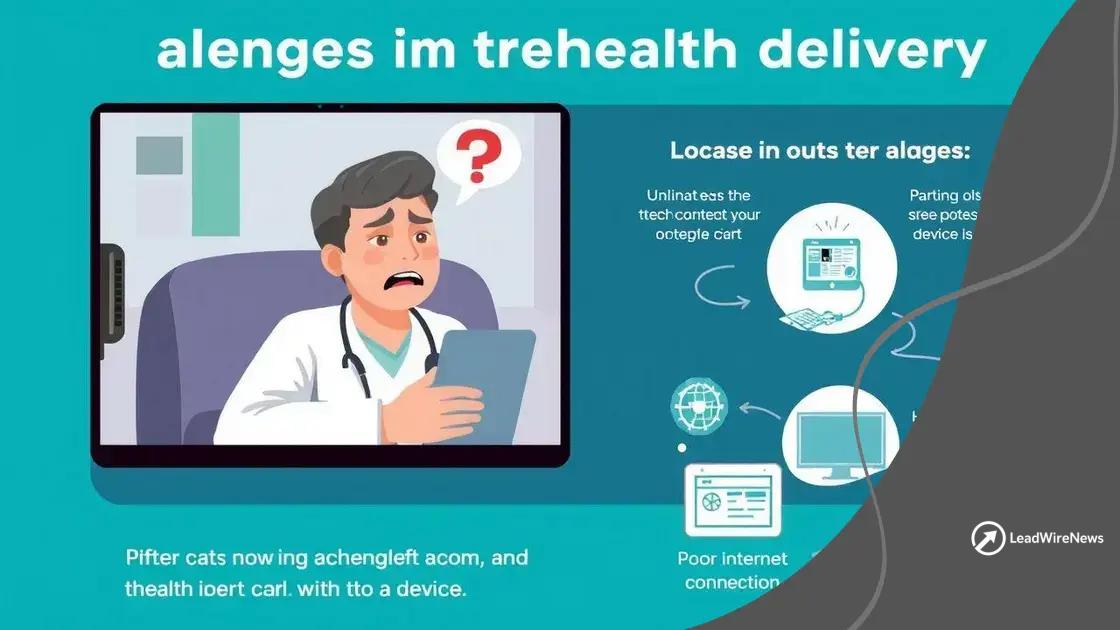Expansion of telehealth service offerings to improve care

Anúncios
Accessing telehealth services involves finding a provider, checking insurance coverage, scheduling an appointment, and ensuring your technology is ready, enabling convenient healthcare from home.
The expansion of telehealth service offerings is becoming increasingly vital in today’s healthcare landscape. Have you ever considered how convenient it is to receive medical care from your home? Let’s uncover what this evolution means for you.
Anúncios
Understanding the evolution of telehealth
Understanding the evolution of telehealth is crucial as we navigate modern healthcare. It’s fascinating how technology has transformed access to medical services, making care available anytime and anywhere.
Initially, telehealth was a concept limited to rare video consultations. Now, it encompasses a wide array of services, increasing convenience and efficiency for patients.
Key Milestones in Telehealth
Several significant milestones have marked the journey of telehealth:
Anúncios
- The introduction of video call technology in healthcare.
- Increased acceptance of telehealth during the COVID-19 pandemic.
- Development of mobile health applications.
- Expansion of insurance coverage for telehealth services.
This evolution shows a shift from in-person visits to virtual consultations, which has helped many patients, especially those in rural areas. Accessing healthcare remotely means that individuals can seek guidance without traveling long distances.
Benefits of Telehealth Evolution
As telehealth continues to grow, its benefits become increasingly clear. Patients can now experience:
- Shorter wait times for appointments.
- Improved management of chronic conditions.
- Greater accessibility and flexibility.
- Enhanced patient engagement through digital tools.
With each advancement, telehealth not only simplifies the process for patients but also alleviates pressure on healthcare systems. The future of telehealth looks bright, allowing for a more integrated approach to healthcare.
Benefits of expanding telehealth services
The benefits of expanding telehealth services are significant for both patients and healthcare providers. With telehealth, patients gain easier access to medical care without the hassle of traveling.
This flexibility allows individuals to fit healthcare appointments into their busy schedules. Plus, the convenience of accessing care from home promotes better adherence to treatment plans.
Key Advantages of Telehealth
Here are some specific advantages of expanding telehealth services:
- Improved Access: Telehealth bridges the gap for those in remote areas, ensuring they receive timely care.
- Cost Savings: Patients save on travel and time, while healthcare providers can reduce overhead costs.
- Enhanced Patient Engagement: With virtual tools, patients become more involved in their own health management.
- Quick Response Times: Telehealth facilitates faster consultations and follow-ups.
As telehealth evolves, it also caters to chronic condition management, offering frequent check-ins that keep both patients and doctors connected. This ongoing communication is vital for effective management of health issues.
Impact on Healthcare Outcomes
Research shows that expanding telehealth services leads to improved healthcare outcomes. Patients are more likely to seek care early on, which can prevent more severe health problems later. Regular access to healthcare professionals means that conditions can be monitored and managed more effectively.
Furthermore, the expansion of telehealth reduces the strain on emergency services. Patients can resolve many issues remotely that might have required immediate and costly intervention otherwise. This not only values patient time but also increases the efficiency of healthcare systems.
Challenges in telehealth service delivery

Challenges in telehealth service delivery are essential to understand as the sector continues to grow. While telehealth offers numerous benefits, several obstacles can affect its effectiveness.
One major challenge is the variability in technology access. Not everyone has a reliable internet connection, which limits the ability to utilize telehealth services. This digital divide can leave certain populations, especially those in rural areas, without adequate access to care.
Technical Issues
Technical difficulties can also occur during virtual visits. Some common problems include:
- Login issues: Patients often face challenges with accessing telehealth platforms.
- Video quality: Poor video and audio quality disrupt communication.
- App incompatibility: Many patients struggle with different devices and software.
- Data security: Concerns about privacy can hinder patient willingness to engage in telehealth.
These technical hurdles can lead to frustration, diminishing the overall experience for both patients and providers. Additionally, inconsistent training among healthcare professionals regarding telehealth tools can also impact service delivery. When providers are not fully equipped to use technology effectively, it can create barriers to delivering quality care.
Regulatory and Reimbursement Issues
Another significant challenge is navigating the regulatory landscape. Laws regarding telehealth vary widely from state to state, which can create confusion and limit services. Moreover, reimbursement policies can be inconsistent, leading some healthcare practitioners to hesitate in offering telehealth options.
This environment makes it difficult for telehealth to gain widespread acceptance. Patients often worry about whether their insurance will cover virtual visits, which can discourage them from seeking care remotely. Addressing these challenges is critical for the successful integration of telehealth into standard healthcare practices.
Future trends in telehealth offerings
Exploring future trends in telehealth offerings is essential to understand how healthcare will evolve. As technology advances, telehealth continues to reshape patient experiences and provider capabilities.
One significant trend is the rise of artificial intelligence. AI can enhance telehealth by offering personalized recommendations and streamlining administrative tasks. This makes it easier for healthcare providers to focus on patient care.
Integration of Wearable Technology
Another exciting development is the increased use of wearable technology. Devices like smartwatches can track vital signs and share data with healthcare providers in real-time. This integration enables:
- Continuous monitoring: Patients can receive feedback on their health conditions at any time.
- Proactive care: Healthcare providers can intervene earlier when issues arise.
- Improved patient engagement: Users feel more involved in their health journey.
This powerful combination of telehealth and wearables offers a more comprehensive view of patient health, leading to better outcomes.
Personalized Care through Telehealth
Personalization is a growing trend that reshapes telehealth services. As patients engage more with healthcare technologies, providers can tailor their approaches based on individual needs. This can include:
- Customized treatment plans: Based on data collected from patients.
- Targeted communication: Providers can send reminders and information specific to each patient.
- Increased follow-up care: Personalized check-ins can lead to higher satisfaction rates.
By focusing on individual patient journeys, the future of telehealth becomes collaborative and responsive. Additionally, the increase in behavioral health services is expected to rise dramatically. This change acknowledges the growing importance of mental health care and remote counseling options.
With these trends and advancements, the landscape of telehealth will continue to expand, providing more opportunities for accessible healthcare.
How to access various telehealth services
Accessing various telehealth services is easy when you know the steps to follow. Many healthcare providers are now offering telehealth options, making it convenient to receive medical care from home.
To get started, it is vital to check what services your doctor or clinic offers. Look for their official website or call their office directly to inquire about available telehealth options.
Steps to Access Telehealth Services
Here are simple steps to access telehealth services:
- Find a Provider: Search for healthcare providers that offer telehealth services. Many hospitals and private practices have adopted this technology.
- Check Your Insurance: Confirm that your insurance covers telehealth visits. This can help reduce your out-of-pocket costs.
- Schedule an Appointment: Once you’ve found a suitable provider, schedule a telehealth appointment through their website or by phone.
- Prepare for Your Visit: Have your medical information handy. Make sure your device is working well and that you have a stable internet connection.
Some platforms may also require downloading specific apps. If this is the case, be sure to download them ahead of time to avoid any last-minute issues.
Using Telehealth Platforms
Many telehealth services use user-friendly platforms that allow easy navigation. During the virtual visit, you can communicate with your healthcare provider via video or chat. Make sure to test your camera and microphone beforehand to ensure everything works smoothly.
After your consultation, you can follow up with your provider through the same platform, making it convenient to continue your care. Some services even offer messaging options to ask questions or get prescription refills.
In conclusion, accessing telehealth services has never been easier. With modern technology, patients can connect with healthcare providers from the comfort of their homes. Understanding the steps to access these services is essential, from finding a suitable provider to scheduling an appointment. The benefits of telehealth extend beyond convenience; they include personalized care and improved healthcare outcomes. As the use of telehealth continues to grow, being informed about the options available empowers patients in their healthcare journey.
FAQ – Frequently Asked Questions about Telehealth Services
What steps do I need to take to access telehealth services?
You need to find a provider offering telehealth, check your insurance coverage, schedule an appointment, and ensure your device is ready.
Are telehealth services covered by insurance?
Many insurance plans do cover telehealth visits, but it’s essential to verify with your specific provider for details.
Can I use telehealth for mental health services?
Yes, telehealth services include mental health care, with many providers offering remote counseling and support.
What technology do I need for a telehealth appointment?
You’ll need a device with a camera and microphone, a stable internet connection, and possibly specific software or apps provided by your healthcare provider.